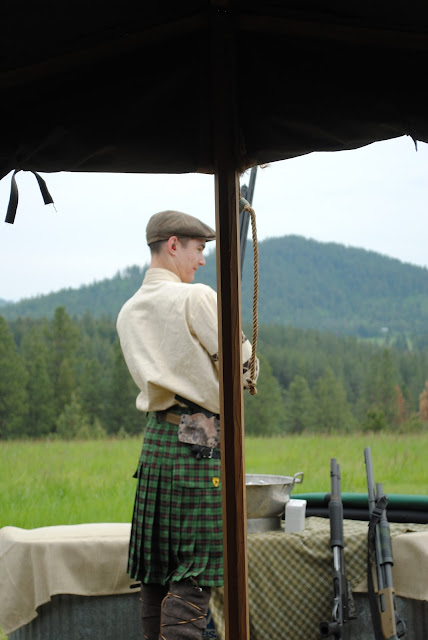When I was growing up, in the pristine mountains at the foot of the Rockies, our winters were long and oh, so cold. As spring bloomed in the low lands, our mountaintop refuge would remain white with snow and we often thought it would be "always winter and never Christmas". And then, ever so imperceptibly, the snow would begin to melt. Rivulets of melted snow would form in the draws and quickly fill the creeks with icy water, adding to the glacier-fed streams cascading from the mountaintops. Little by little, green patches of new grass would begin showing through the snow and by May, a deep green carpet would blanket the hills and vales. Spring had arrived.
 |
| Camas as far as the eye can see |
As spring brought new life to our little homestead, it also brought extraordinary beauty. Almost as soon as the fields replaced their white coat with green, they would again exchange green for blue - oceans of blue. Camas, a beautiful blue flower, grows rampant in the fields around my childhood home, transforming our fields of waving grass into oceans of rippling blue.
 |
| Freshly picked bulbs |
Camas, a delicate and lacey flower, is more than just a pretty face. It is also a traditional Native American food source. Nez Perce Indians customarily harvested Camas in the spring, baked the bulbs in stone ovens for extended periods of time, dried the cooked bulbs and pounded them into flour for the baking of flat bread. They also baked the camas (again, in stone ovens) and ate them like potatoes. Camas bulbs were a main food source, along with Steelhead salmon, during the early months of spring and summer, when other food sources were scarce. In fact, the Nez Perce offered camas bulbs and steelhead fish to the Lewis and Clark party when they were nearly starving on their way to the Pacific ocean.


Last weekend, Sir Knight and I delivered a wood cook stove to my parents and as we were driving through the mountainous fields of my childhood home, we noticed that the camas was in full bloom. Although I grew up attending the "Camas Festival", I had never tried camas before, much less taken the time to dig and cook the delicate bulb. Deciding that we needed to know more about this abundant natural resource, Sir Knight and I dug a few bulbs on our way home.
After reading various methods and recipes, we decided that a crock pot set on low would be the easiest (though, least authentic) way to cook camas for the time required. Camas is full of inulin, an indigestible starch, that in only broken down through long cooking times at low temperatures. The inulin, if not properly broken down through extended cooking times, causes lower intestinal discomfort and extreme flatulence - definitely not recommended!
 |
| Leave flowers on the bulb until ready to prepare |
 |
| Ready to cut and clean |
 |
| Taking the outer skins off |
After cleaning and stripping the outer layers from the bulbs, I put them in the crock pot (reserved for summer use only, when our solar panels are collecting massive amounts of energy) with a tiny amount of water and set the crock pot on low. Occasionally (every 4 or 5 hours) I stirred the bulbs and added a bit more water when needed. By the time the camas bulbs had been cooking for 24 hours, they had begun to carmelize and turned a lovely golden brown. I tested a small bulb and I have to admit, they were a bit soft and flavorless. Apparently camas sweetens as it cooks and 24 hours wasn't enough.
 |
| Cleaned and in the crock pot |
 |
| After cooking for 24 hours |
Camas has an intriguing, almost yeasty smell as it cooks. It brown nicely and although it becomes very soft, it never gets mushy. After the camas had cooked for 48 hours, I tried it again. It was slightly sweeter this time, however, it still didn't have a lot of flavor. A recipe I came across said to slice the bulbs (after they had been cooked) saute them in olive oil or butter, lightly salt them and serve, so that is what I did.
 |
| Sautéed with butter and salt |
I have to admit - the camas was anticlimactic. It was good, but plain. Mostly, I noticed that camas doesn't have much of its own flavor, it borrows flavor from whatever it is cooked with. Since I sauteed the camas with butter and salt, it tasted like butter and salt. I can imagine if it were dried and pounded into flour, it would make a very nice addition to more conventional flours for flat breads or tortillas.
Sir Knight and I had a wonderful trip to my parents and a lovely afternoon picking camas in fields of blue. Although we probably won't make harvesting camas a yearly adventure, we know we could harvest it if we had to. What a beautiful gift from God!
Before you give harvesting camas a try, make sure you know the difference between blue camas and death camas. They both like to grow in the same area and while one will sustain life, the other will, at the least, make you sick, and at worst kill you! Make sure you know what you are foraging!
What a joy to walk through oceans of blue in fields of green!



















































